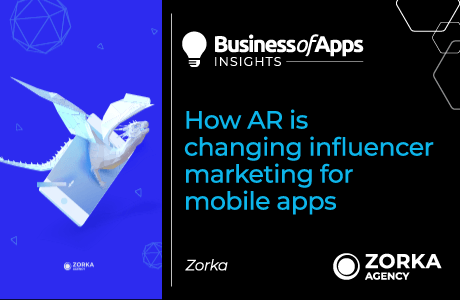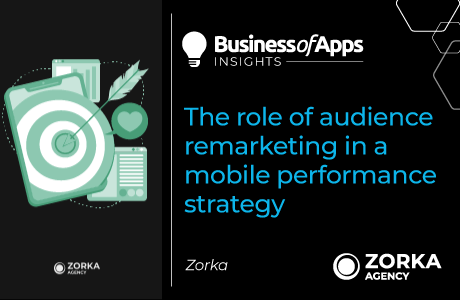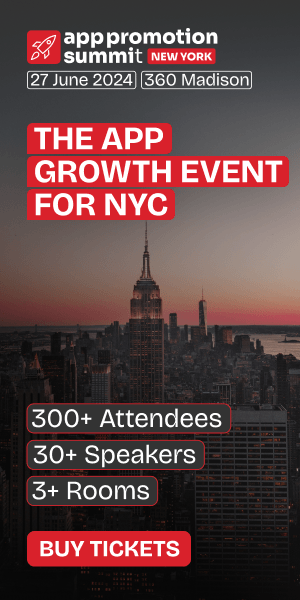Remarketing is a digital marketing strategy that involves targeting users who have previously interacted with the brand but did not convert into customers, as well as past customers. Mobile app remarketing focuses on re-engaging users who have already installed a mobile app but have not taken specific actions or have become inactive. Its goal is to motivate them to take further action.
The following are the primary business tasks that remarketing helps to:
- Increase engagement. By delivering personalized messages and offers, remarketing allows marketers to re-engage with users, i.e. potential customers.
- Boost conversions. This personalized approach increases conversions as marketers focus on an audience that is more receptive and closer to making a purchase decision.
- Win back users. Remarketing campaigns re-establish a connection with users, reminding them of the value of the product it offers.
- Strengthen brand loyalty. Through consistent exposure to remarketing ads, users are repeatedly exposed to the brand within their information field. This sustained presence has a positive impact on user loyalty and perception.
What I particularly appreciate about remarketing is its ability to focus on individuals who have previously shown interest in the brand. This approach mitigates the potential for mass rejection that can occur when approaching random strangers. Unlike other marketing methods, remarketing capitalizes on existing interest, adding value to cold contacts. By employing a personalized approach for the ads, the audience feels the brand’s care, leading to improved ROI.
Thus, by optimizing ad spend by targeting a specific audience that has already shown interest in the brand, remarketing plays a crucial role in driving the performance of marketing campaigns.
How to define a remarketing audience?
The buyer of sweets in a store can vary depending on the specific context. In some cases, parents may be the primary purchasers as they make buying decisions for their children, while in other cases, children themselves may be the buyers if they have the autonomy to make their own purchasing choices. This demonstrates a non-obvious audience of consumers where both parents and children should be considered as customer groups. Additionally, gift buyers who purchase goods for others rather than themselves are another example of a non-standard audience of buyers. When constructing digital marketing funnels, it is crucial to consider these diverse buyer personas and think creatively beyond the obvious target audience.
And when it comes to audience remarketing in mobile applications, marketers should consider two approaches: the obvious case and the non-obvious case.
- In obvious cases, the focus is on targeting individuals who have clear connections to the product or app being promoted. This entails identifying users who have demonstrated explicit interest or engagement in related areas. It is crucial to carefully segment this audience to ensure effective targeting and engagement.
- In non-obvious cases, remarketing involves indirectly targeting audience individuals who have shown interest in the brand’s social media pages or those who have demonstrated interest in an ad but haven’t downloaded the application. This approach expands the reach and potential conversion opportunities by focusing on users who have demonstrated some level of engagement or curiosity but haven’t yet taken the desired action of downloading the app.
By considering both the obvious and non-obvious cases, marketers can explore different audience segments and broaden the reach of their remarketing efforts. This comprehensive approach allows for a more effective and nuanced targeting strategy in mobile applications.
Key aspects of implementing a remarketing strategy in mobile app promotion
When initiating a remarketing campaign for mobile apps, marketers should pay close attention to various aspects. These include implementing in-app tracking to gather valuable user data and tracking data from the SDK of traffic sources in use. Additionally, marketers should focus on product analytics and collecting first-party data of the application, which can include phone lists, email addresses, and device IDs for remarketing purposes. Providing attractive incentives to re-engage users, utilizing push notifications and in-app messaging for personalized communication, and optimizing app store listings are also vital for enhancing visibility and discoverability. But also launching remarketing strategy for promoting mobile applications and mobile games additional attention should be paid to:
Audience segmentation
Remarketing audiences are consistently segmented based on their engagement levels. Higher-level demographics and interests are often insufficient for precise targeting. Instead, segmentation can be achieved by analyzing in-app activities, gaming preferences, and spending habits. By focusing on specific in-app actions and entry/exit points, marketers can create more effective remarketing segments and tailor their strategies accordingly. This approach allows for a more personalized and targeted remarketing campaign that is likely to yield better results.
Struggling with Global App Growth?
Reach a wider quality audience with Zoomd’s ingenious UA technologies and services. Boost downloads, sign-ups, and engagement the smart way.
Learn MorePersonalized content
Personalization is key in mobile app and game remarketing. Content, such as ads, notifications, or in-app messages, should be tailored to the preferences and behaviors of each user segment. As a result, dynamic remarketing, following the principle of personalization in e-commerce, typically outperforms regular static remarketing by yielding better outcomes. Personalized content increases user engagement, as it feels more relevant and appealing to individual users.
Timing and frequency
Are you sure you’re reaching out to users at the right times when they’re most likely to be receptive to your messages? For example, in games, you might want to redirect users after they complete a difficult level or after they haven’t played in a while. In addition, the marketer must be mindful of frequency limits so as not to overwhelm users with excessive remarketing ads, which can lead to ad fatigue and a negative user experience.
Drawing a gamer’s roadmap
Mapping the gamers’ journey is an important aspect of remarketing for mobile games. By understanding the different stages and touchpoints in a player’s journey, specific opportunities for remarketing could be identified. For example, if a player reached a specific level but hasn’t played in a while, a marketer can remarket them with incentives or reminders to encourage them to continue their progress. Mapping the gamers’ journey helps to target specific pain points or moments where users might need extra motivation or assistance.
Attribution and measurement
The main motto is to drive progress by embracing analysis and taking action. Accurate attribution and measurement are essential for evaluating the effectiveness of remarketing efforts. To achieve this, it is crucial to utilize mobile attribution platforms or analytics tools to track and measure the impact of remarketing campaigns on important performance indicators such as installations, in-app purchases, and user engagement.
How to boost conversion with remarketing?
Boosting conversions with remarketing requires a strategic approach and careful implementation of various techniques. Among them:
Call to action
A clear and compelling call to action (CTA) is crucial in remarketing campaigns. It prompts users to take the desired action, such as making a purchase, signing up for a newsletter, or downloading an app. The CTA should be concise, visually prominent, and communicate the value proposition effectively. It’s important to remember that the call to action may vary depending on the specific audience being targeted.
A/B testing
By creating different versions of your remarketing ads or landing pages and testing them with a subset of your target audience, a marketer can identify the most effective elements, such as visuals, messaging, colors, or layouts.
Creatives
Utilizing a variety of creative formats, such as videos, motion graphics, or interactive ads, can enhance engagement and boost conversions. Visual and interactive elements capture users’ attention and convey the ad’s message more effectively. Creatives used in a remarketing strategy will be more personalized since the target user’s story is known.
Constant approach
Consistency plays a crucial role in remarketing campaigns. Maintaining a constant presence in front of the target audience is essential to keep the brand at the forefront of their minds. A regular and consistent remarketing approach reinforces brand recall and enhances the likelihood of conversion. Achieving this requires setting up remarketing campaigns with suitable frequency and duration, ensuring that the ads or messages are consistently displayed to the targeted users throughout their customer journey.
Double segmentation
When segmenting the audience for remarketing, it is crucial to consider the process of “re-segmentation” to determine which audience segments should be excluded from receiving impressions. This involves creating complex conditions within the remarketing strategy, such as targeting individuals who have registered but have not yet engaged with the product or service.
Summing up
In conclusion, remarketing plays a crucial role in a performance mobile marketing strategy by re-engaging users who have previously interacted with the brand. It capitalizes on existing interest, adding value to cold contacts and leading to an improved return on investment (ROI).













